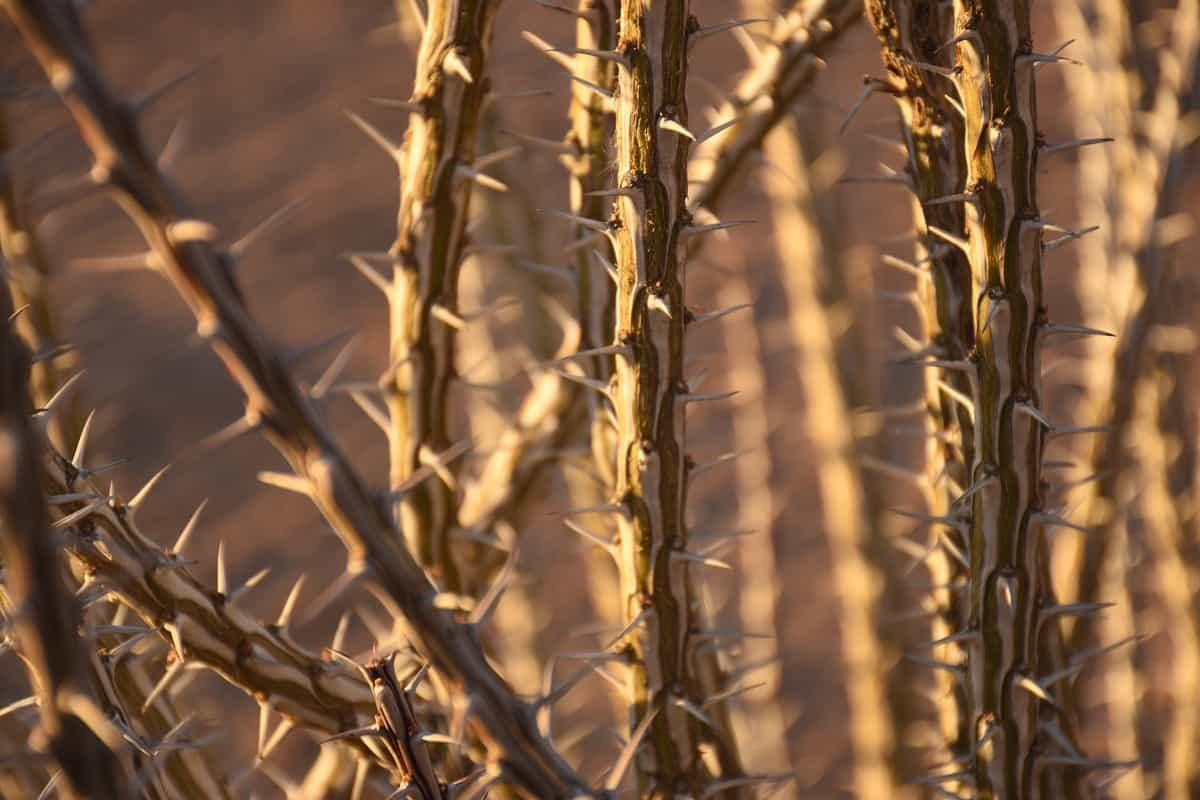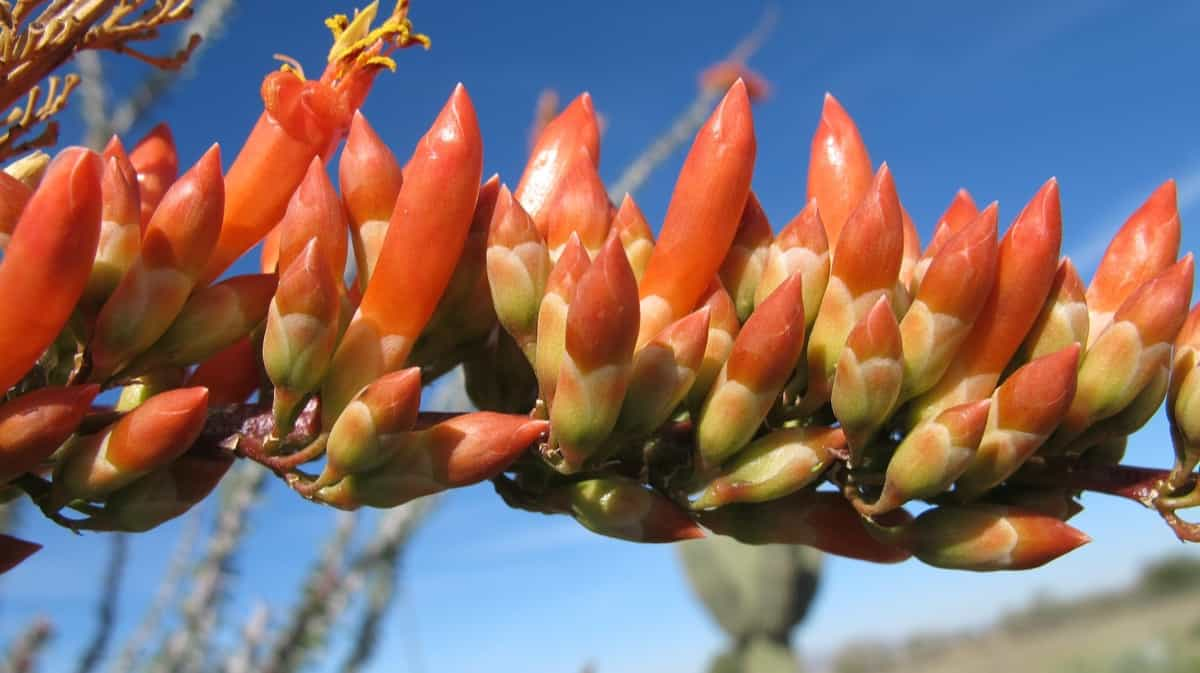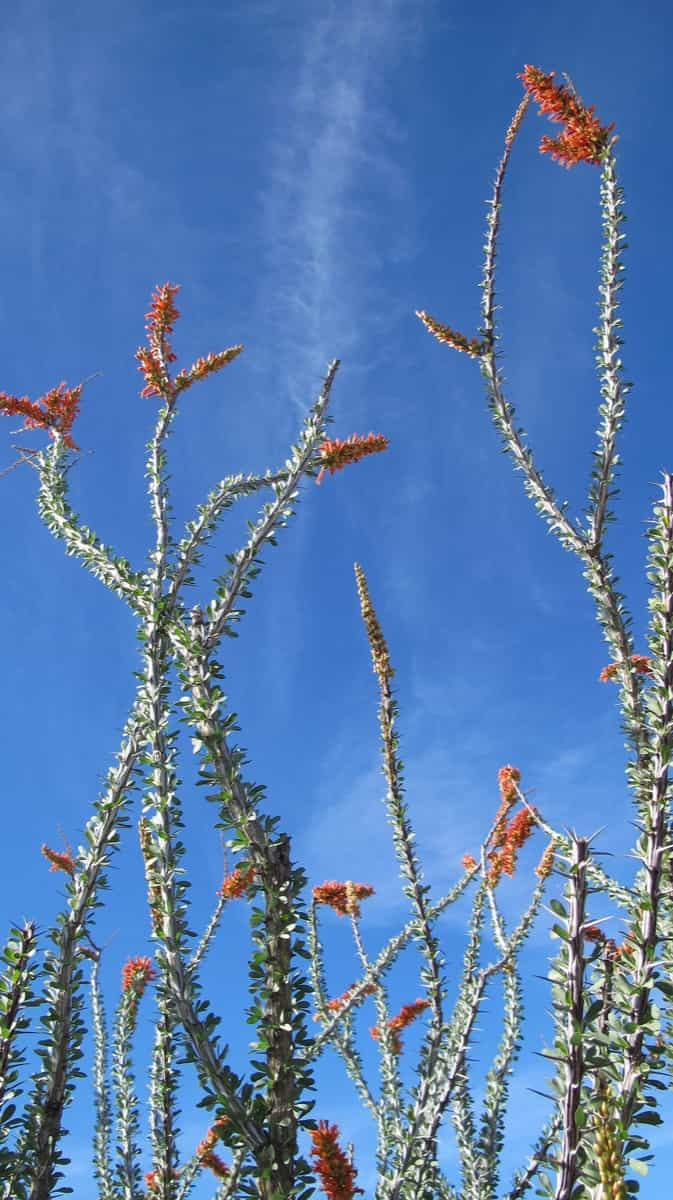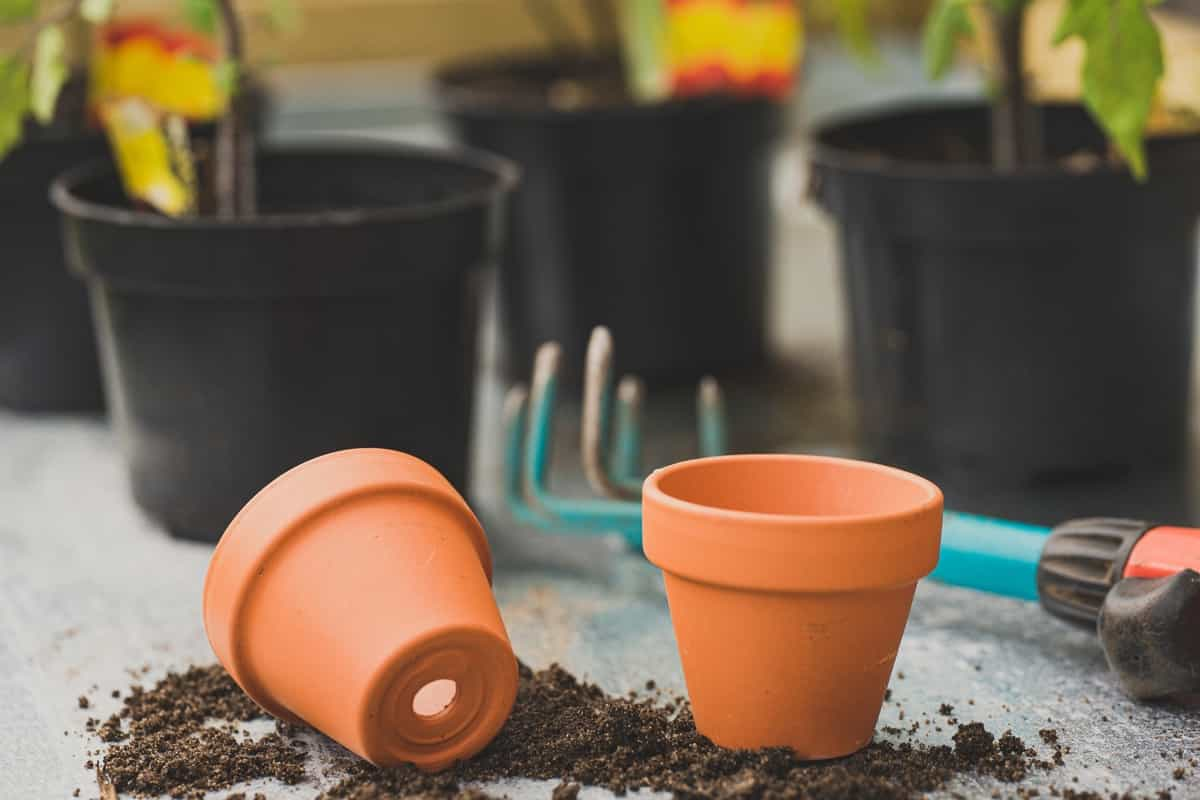Ocotillo is a tall, spiny plant; its stems are green and photosynthetic but also covered in small spines. Consider growing Ocotillo in pots if you’re looking for a drought-tolerant, low-maintenance plant that will add beauty to your landscape. One of the biggest benefits of growing Ocotillo in pots is that it’s relatively easy to care for.

Unlike many other plants, Ocotillo doesn’t need much water or fertilizer to thrive. Its long, slender stems are covered in small leaves ranging from green to red. Ocotillo produces beautiful red flowers that attract bees and hummingbirds in the spring and summer.
How to grow and care for Ocotillo in pots
Climate suitable for growing Ocotillo
- It has thin, spiny leaves arranged in whorls along its stems. The leaves are deciduous, meaning they fall off the plant during the dry season. The Ocotillo stems are green and photosynthetic, so they can produce food for the plant even when the leaves are not present. Ocotillos are desert plants, so they need full sun to thrive. In pots, they should be placed in a sunny spot where they will get at least 6 hours of direct sunlight each day. In a hot climate, you may need to provide afternoon shade for your potted Ocotillo.
- The Ocotillo is adapted to living in a hot, dry climate. It does not need much water to survive and can tolerate long periods without rain. This makes it a good choice for growing in pots or other containers, as it will not need to be watered like other plants. So if you live in a hot, dry climate, you can grow Ocotillo in your yard or garden. Just make sure to choose a spot with full sun and well-drained soil.
In case you missed it: How to Grow and Care for Chinese Evergreen Indoors: Tips and Ideas for Beginners

Soil requirement for growing Ocotillo
This unusual succulent has long, spiny stems covered in small, bright green leaves. Ocotillo prefers well-drained, sandy loam soil with a pH between 6.0 and 8.0. If your pot doesn’t have adequate drainage, consider adding sand or perlite to the potting mix. You can also improve drainage by planting Ocotillo in raised beds. While Ocotillo is tolerant of a wide range of conditions, it does have some specific soil requirements. The plant’s roots prefer well-draining soil, so using a potting mix with ingredients like perlite or sand is important. Ocotillo also needs plenty of sunlight to thrive, so choose a location in your garden that gets full sun exposure.
Water requirement for growing Ocotillo
- Water is an essential element for growing Ocotillos in pots. When watering your Ocotillo, give the roots a good soaking. Water deeply and slowly so that the water can penetrate the soil and reach the roots. If you are growing Ocotillo in containers, check the soil regularly to see if it needs watering. The watering frequency will depend on the size of the pot, the type of soil, and the weather conditions. Container-grown Ocotillos will need to be watered more often than those grown in the ground.
- When planting your Ocotillo, water it well and allow the soil to dry before watering. This will help encourage deep root growth. Once your plant is established, you can cut back on watering somewhat, but make sure not to let the soil get too dry. If your plant starts to wilt or look stressed, it is probably not getting enough water.
Pot size required for growing Ocotillo
Choose a pot at least 18 inches wide and 18 inches deep to ensure your Ocotillo has enough space to grow and thrive. In hot climates, choose a larger pot so your plant can take advantage of the extra space to stay cool. Place your pot in an area that receives full sun for the best results. You can use terracotta pot for growing Ocotillo.
In case you missed it: How to Grow and Care for Arrowhead Vines Indoors

Terracotta is a great pot material because it’s breathable, which is important for a plant like an Ocotillo that needs good drainage. Plus, terracotta pots are affordable and easy to find. Any pot with good drainage will work if you can’t find a terracotta pot. Just make sure to punch some holes in the bottom of the pot before adding soil so that water can drain out easily.
Propagating Ocotillo
From cuttings
To propagate Ocotillo in pots, take cuttings from the tips of healthy branches. Each cutting should be about 6 inches long and have at least two leaves. Fill a pot with well-draining cactus mix or sand and insert the cuttings about an inch deep. Water the soil lightly, making sure not to soak it. Place the pot in a bright spot but out of direct sunlight until new growth appears. Once the new growth is 3-4 inches tall, you can transplant it into its pot or the ground.
From seed
If you have Ocotillo seeds that you would like to use to propagate new plants, there are a few things you will need to do to ensure that they germinate and grow successfully. First, fill a seed flat or tray with a well-draining cactus mix or sandy loam soil. Next, lightly press the seeds into the soil, taking care not to bury them too deeply. Water the soil gently so that it is evenly moistened but not saturated. Place the seed flat in a warm location from direct sunlight and moisten the soil until the seeds germinate.
In case you missed it: How to Grow and Care for Clematis: A Beginners Guide

Transplanting Ocotillo seedlings
To transplant Ocotillo seedlings, prepare the pot by adding a layer of gravel or sand to the bottom for drainage. Then fill the pot with a quality cactus mix or sandy loam soil. Water the soil regularly and allow it to drain before planting the seedlings. Gently remove the seedlings from their current pots and plant them in the prepared pots, making sure they are at the same depth they were previously growing.
Once all the seedlings are transplanted, water them again and place them in a warm, sunny location. Keep the soil moist, and fertilize monthly with a balanced fertilizer. With proper care, your Ocotillo seedlings should thrive in their new pots.
Ocotillo plant care
Fertilizer requirement for growing Ocotillo
When growing Ocotillo in pots, it is important to use a well-drained potting mix and to fertilize regularly. A high-quality, all-purpose fertilizer will provide the nutrients needed for healthy growth. During the growing season, fertilize monthly using a half-strength solution. Ocotillo often does not need fertilizer in the landscape since it is adapted to living in nutrient-poor soils.
However, if you want to boost your Ocotillo, you can use a low-nitrogen fertilizer such as 1-2-1. Apply the fertilizer around the bottom of the plant in early spring before new growth begins. To maintain healthy growth, Ocotillos should be fertilized regularly.
Pruning Ocotillo plant
Pruning Ocotillo is a bit different than pruning other plants. First, you’ll want to wait until the plant is completely dormant before pruning it. This usually occurs in late winter or early spring. Next, cut back all of the dead wood from the plant. You can do this with pruning shears. Finally, thin out the plant by removing any crowded or crossed branches. This will help improve air circulation and sunlight exposure for the plant.
In case you missed it: How to Grow and Care for ZZ Plants Indoors: A Beginners Guide

Repotting Ocotillo plant
Ocotillo is a succulent, so it doesn’t need much water to survive. Too much water can kill an Ocotillo. The plant grows well in full sun and well-drained soil. If you’re growing Ocotillo in a pot, you’ll need to repot it every few years to give the roots room to grow. When repotting, use a pot slightly larger than the previous one.
Be sure to use cactus potting mix or well-drained garden soil. To repot an Ocotillo, start by removing the plant from its pot, placing it in the new pot, and filling it with fresh potting mix or garden soil. Water thoroughly after repotting.
Ocotillo plant care in winter
If you live in a climate where it gets cold in the winter, you will need to take some extra care of your Ocotillo in pots. Bring your potted Ocotillo indoors or into a garage or shed when nighttime temperatures dip below 10°C. Water your Ocotillo less frequently in winter, as the plant will be dormant and won’t need as much moisture. Let the soil dry completely between watering. Fertilize your Ocotillo sparingly in winter, as too much fertilizer can damage the roots. A light application of an all-purpose fertilizer once every few months should be sufficient.
Pests and diseases of the Ocotillo plant and their control
Pests and diseases are a major problem for Ocotillos, as they can severely damage or even kill the plant. Aphids are small, sap-sucking insects that cause leaves to curl, distort, and spread plant viruses. Spider mites suck the sap from leaves, causing them to turn yellow or brown and eventually drop off. Scale insects are also sucking insects that attach themselves to the stems and leaves of Ocotillos, causing them to turn yellow or brown and eventually die. Various fungal diseases can attack Ocotillos, causing leaf spot, root rot, or stem rot.
One of the most common pests of Ocotillo is the cactus moth. This moth lays its eggs on the stems of Ocotillo, and when the larvae hatch, they bore into the stem and feed on the plant tissue. Cactus moths can cause significant damage to Ocotillo, especially if left unchecked. There are several ways to control cactus moths. One method is to remove any infested stems from the plant and dispose of them. This will help to prevent the spread of the pest. Another method is to use a registered insecticide such as carbaryl or diazinon. These products should be applied according to label directions.
There are a few different ways to control Ocotillo pests and diseases. One way is to use a chemical insecticide or fungicide. Another way is to remove the pests or diseases from the plant physically. You can also try using biological control, such as introducing a natural enemy of the pest or disease. If you decide to use a chemical insecticide or fungicide, read the label carefully and follow all directions. Apply the product according to the label instructions, and cover all plant parts affected by the pest or disease.
In case you missed it: How to Grow and Care for Rhododendrons: A Beginners Guide

If you decide to remove pests or diseases from the plant physically, you can do this by hand-picking them off or using a sharp knife or scissors to cut them away. Be sure to dispose of any affected plant parts in a trash bag so they don’t spread back to the Ocotillo.
Conclusion
Ocotillo is a great option if you’re looking for a fun and easy plant to propagate. You can have new plants quickly with just a few simple steps. And best of all, they require very little care once established. So, if you’re looking for a low-maintenance plant to add to your collection, the Ocotillo is worth considering. These plants are relatively easy to grow, but you must remember a few things when growing them in pots. Ocotillo can make a beautiful and unique addition to your home with the right care.
- Where to Place Indoor Plants in Your Home
- How to Grow Tomatoes Organically at Home: A Comprehensive Guide
- Organic Gardening on a Budget: Low-Cost Methods and Materials
- Gongura Seed Germination and Planting Methods
- Cabbage Seed Germination and Selection
- Broccoli Seed Germination and Selection
- Asparagus Seed Germination and Variety Selection
- Seasonal Flower Gardening: Best Practices for Spring, Summer, Fall, and Winter
- How to Grow Hibiscus from Flower
- Plantation Ideas for Home Decoration: A Beginners Guide
- Flower Garden Designs and Layouts for Beginners
- Planting and Spacing Techniques in Papaya: A Beginner’s Guide
- Growing Gold: Essential Techniques for Planting Pineapples
- How to Make Kalanchoe Plant Bushy: Home Remedies and Solutions
- 11 Reasons Why Your Gardenia is Not Blooming: Home Remedies and Solutions
- Eco Elegance: The Guide to Designing a Drought-Tolerant Landscape
- Gardening on a Slope: Strategies for Hillside Landscaping
- Nourish and Flourish: Top Organic Mulches for Thriving House Plants
- Everything You Want to Know about Indian Mogra Flower: Discover Uses and Growing
- Green Thumb Success: Expert Tips for Cultivating Greenhouse Pumpkins All Year Round
- Maximize Growth & Flavor: The Ultimate Guide to Companion Planting in Herb Gardens
- How to Control Rhododendron Problems Naturally: Home Remedies and Organic Ways to Fix Them
- Natural Magic: The Remarkable Benefits of Cinnamon for Plants
- Best Steps to Revive Dying Tulip with Natural and Organic Treatment
- 10 Reasons Why Your Angel Trumpet is Not Blooming: Remedies and Treatment
- How to Fix Periwinkle Leaf and Flower-Related Problems: Natural Remedies and Solutions
- How to Fix Zinnias Leaf and Flower Problems: Discover Natural and Home Remedies
- Organic Steps to Induce Lemon Tree Flowers: A Comprehensive Guide
- Bloom Booster: Crafting the Perfect Homemade Bougainvillea Fertilizer
- Optimizing Growth: A Guide to Applying NPK Fertilizer for Potted Plants
- 10 Best Homemade Fertilizers for Rubber Plant: DIY Recipes and Application Method
- How to Boost Female Pumpkin Flowers: Effective Steps for More Flowers and High Yields
- Transform Your Indoor Garden: Top Benefits of Pink Salt for Houseplants
- 10 Best Homemade Fertilizers for Peacock Plants (Calathea): Easy DIY Guide
- Unlock Blooms: 9 Reasons Why Your Potted Chrysanthemum is Not Blooming
- 8 Reasons Why Your Potted Hibiscus is Not Blooming: Fix it with Simple Solutions